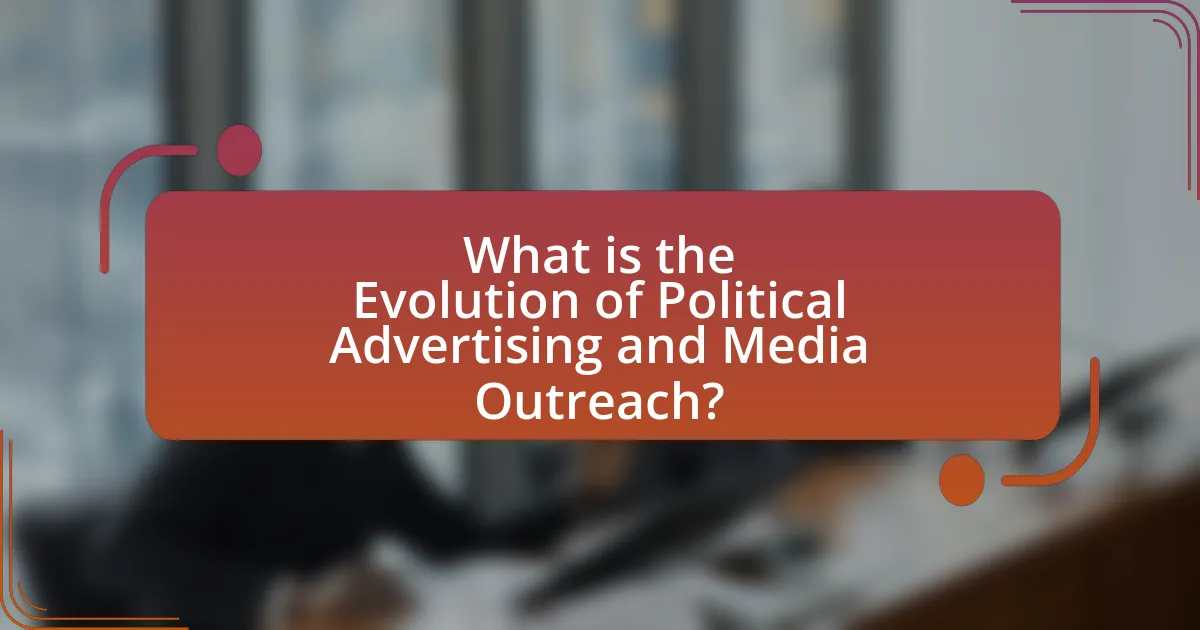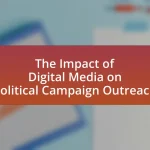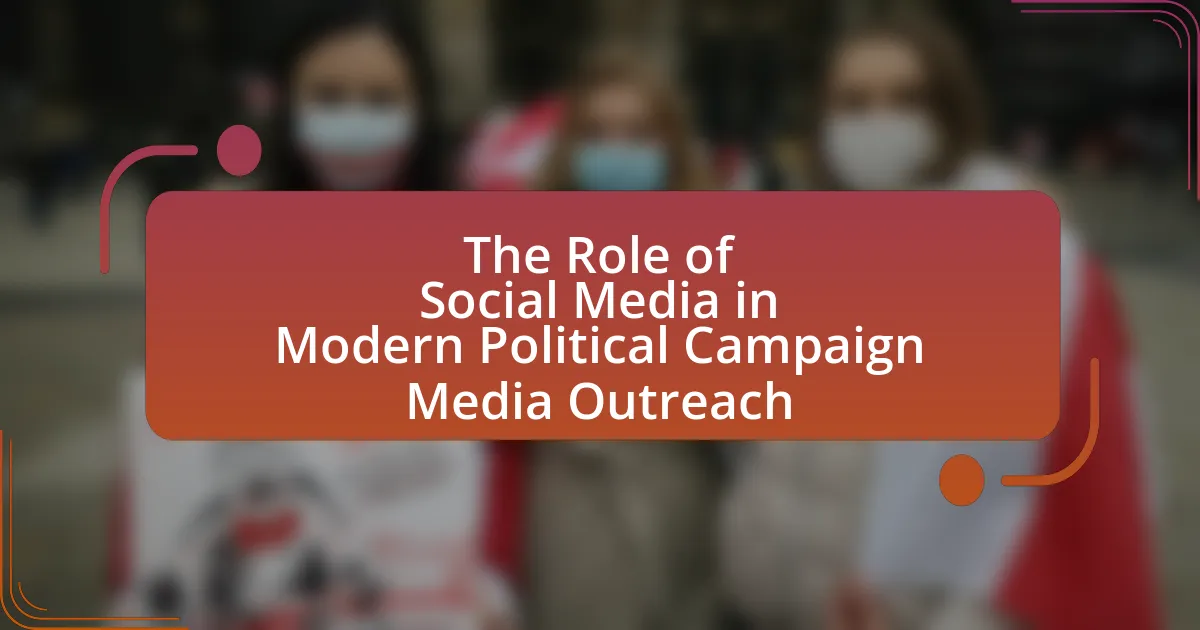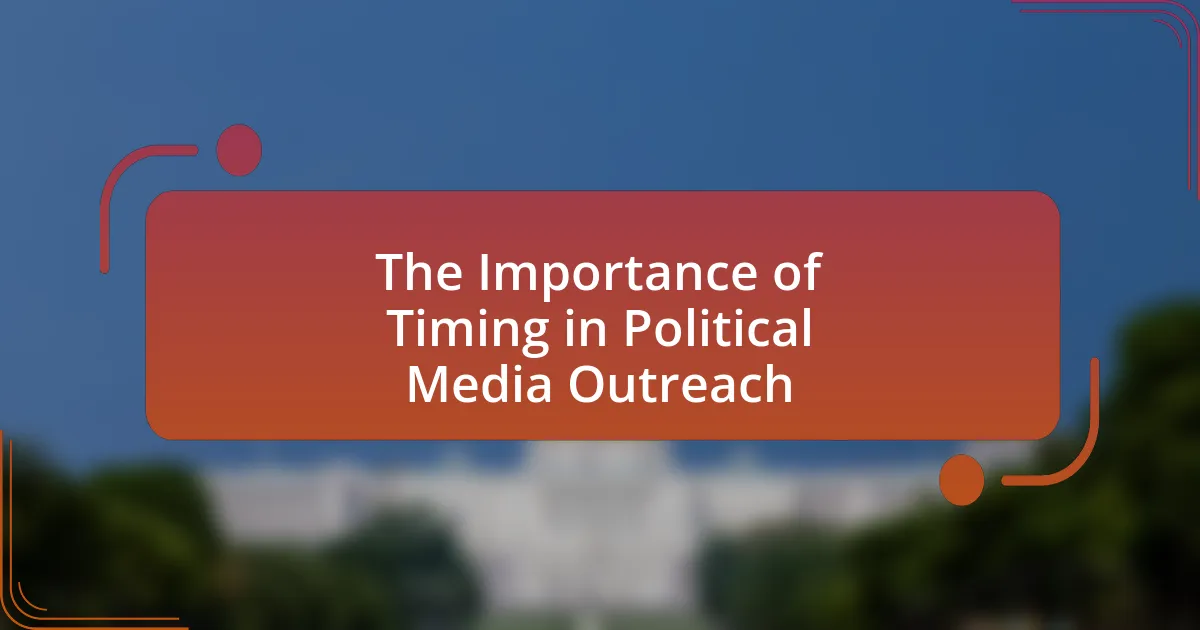The article examines the evolution of political advertising and media outreach, highlighting the transition from traditional methods to digital platforms. It outlines key milestones in the history of political advertising, such as the introduction of television and the rise of social media, which have transformed how candidates engage with voters. The discussion includes the impact of technological advancements, the importance of media outreach in shaping public perception, and the strategies employed by campaigns to effectively utilize social media. Additionally, it addresses the challenges posed by misinformation and the future trends in political advertising, emphasizing the role of data analytics and artificial intelligence in shaping campaign strategies.

What is the Evolution of Political Advertising and Media Outreach?
The evolution of political advertising and media outreach has transitioned from traditional methods to digital platforms, significantly altering how candidates communicate with voters. Initially, political advertising relied on print media, such as newspapers and pamphlets, to disseminate messages. The introduction of radio and television in the mid-20th century revolutionized outreach, allowing candidates to reach broader audiences through visual and auditory means. For instance, John F. Kennedy’s televised debates in 1960 exemplified the impact of visual media on public perception.
With the advent of the internet in the late 20th century, political advertising began to incorporate online strategies, including email campaigns and social media outreach. The 2008 Obama campaign effectively utilized social media platforms to engage younger voters, demonstrating the power of digital communication. By 2020, political advertising had further evolved, with data analytics and targeted advertising becoming central to campaigns, allowing for personalized messaging based on voter demographics and behaviors.
This evolution reflects a shift towards more interactive and immediate forms of communication, enabling candidates to respond quickly to public sentiment and engage with constituents in real-time. The increasing reliance on digital platforms has transformed the landscape of political advertising, making it more dynamic and responsive to the electorate’s needs.
How has political advertising changed over the decades?
Political advertising has evolved significantly over the decades, transitioning from traditional media to digital platforms. In the 1950s and 1960s, political campaigns primarily relied on television and radio, with candidates using simple, direct messages to reach voters. By the 1980s and 1990s, the introduction of cable television allowed for more targeted advertising, enabling campaigns to tailor messages to specific demographics.
The rise of the internet in the late 1990s and early 2000s marked a pivotal shift, as campaigns began utilizing websites and email to engage voters directly. In the 2010s, social media platforms like Facebook and Twitter became essential tools for political advertising, allowing for real-time interaction and micro-targeting based on user data.
This shift to digital advertising has led to increased spending, with the 2020 U.S. presidential election seeing over $6.6 billion spent on digital ads alone, reflecting a growing reliance on online platforms to influence voter behavior. The evolution of political advertising demonstrates a clear trend towards more sophisticated, data-driven strategies that leverage technology to maximize outreach and engagement.
What were the key milestones in the history of political advertising?
The key milestones in the history of political advertising include the introduction of the first political campaign poster in the 1820s, which marked the beginning of visual political communication. In 1924, the first radio broadcast of a political campaign took place, allowing candidates to reach a broader audience. The 1952 Eisenhower campaign utilized television ads effectively, setting a precedent for future campaigns. The 2008 Obama campaign leveraged social media for grassroots mobilization, revolutionizing digital political advertising. Each of these milestones significantly shaped the strategies and effectiveness of political communication throughout history.
How did technological advancements influence political advertising?
Technological advancements significantly transformed political advertising by enabling targeted messaging and real-time engagement with voters. The rise of digital platforms, particularly social media, allowed campaigns to analyze voter data and tailor advertisements to specific demographics, increasing the effectiveness of outreach efforts. For instance, during the 2008 U.S. presidential election, Barack Obama’s campaign utilized data analytics to identify and reach potential supporters through platforms like Facebook and Twitter, resulting in a more personalized voter engagement strategy. This shift not only enhanced the precision of political messaging but also facilitated immediate feedback and interaction, fundamentally changing how candidates communicate with the electorate.
Why is media outreach important in political campaigns?
Media outreach is crucial in political campaigns because it amplifies a candidate’s message and engages voters effectively. By utilizing various media channels, campaigns can reach a broader audience, ensuring that their policies and values are communicated clearly. For instance, a study by the Pew Research Center found that 62% of adults get their news from social media, highlighting the importance of digital platforms in shaping public opinion. Additionally, effective media outreach can enhance a candidate’s visibility and credibility, as consistent coverage in reputable outlets can influence voter perceptions and increase support.
What role does media outreach play in shaping public perception?
Media outreach plays a critical role in shaping public perception by disseminating information and influencing narratives about political figures and issues. Through strategic communication efforts, media outreach enables political campaigns to frame their messages, highlight key issues, and respond to public concerns, thereby guiding how the audience interprets events and policies. For instance, studies have shown that targeted media campaigns can significantly sway voter opinions, as evidenced by the 2008 Obama campaign, which effectively utilized social media outreach to engage younger voters and shape their perceptions of the candidate. This demonstrates that media outreach not only informs the public but also actively molds their views and attitudes toward political entities.
How do different media platforms impact political outreach strategies?
Different media platforms significantly impact political outreach strategies by shaping how messages are delivered and received by the electorate. Social media platforms, for instance, allow for targeted advertising and real-time engagement, enabling campaigns to reach specific demographics effectively; a study by the Pew Research Center found that 69% of adults in the U.S. use social media, making it a crucial tool for political communication. Traditional media, such as television and radio, still play a vital role in reaching broader audiences, particularly older voters, as evidenced by the fact that 90% of U.S. households have a television. The integration of digital and traditional media strategies allows political campaigns to maximize their outreach by leveraging the strengths of each platform, thus enhancing voter engagement and mobilization efforts.
What are the main types of political advertising?
The main types of political advertising are television ads, digital ads, print ads, and outdoor advertising. Television ads remain a dominant form, reaching a wide audience through local and national broadcasts, while digital ads leverage social media platforms and search engines for targeted outreach. Print ads, including flyers and newspaper advertisements, provide tangible materials for voters, and outdoor advertising, such as billboards, captures attention in public spaces. Each type plays a crucial role in shaping public perception and influencing voter behavior during elections.
How do traditional media ads differ from digital ads?
Traditional media ads differ from digital ads primarily in their format and audience engagement. Traditional media ads, such as television, radio, and print, are typically one-way communication channels that deliver messages to a broad audience without immediate feedback mechanisms. In contrast, digital ads, which include social media, websites, and email marketing, allow for two-way interaction, enabling advertisers to engage directly with consumers and receive real-time feedback. For instance, a study by the Interactive Advertising Bureau found that digital advertising allows for targeted campaigns based on user data, resulting in higher engagement rates compared to traditional media, which often relies on demographic assumptions.
What are the advantages of grassroots campaigning in political advertising?
Grassroots campaigning in political advertising offers several advantages, primarily its ability to foster authentic connections with voters. This approach relies on mobilizing local supporters who can engage their communities directly, creating a sense of trust and relatability that traditional advertising often lacks. For instance, studies have shown that candidates who utilize grassroots strategies can increase voter turnout by as much as 10% compared to those who rely solely on mass media campaigns. Additionally, grassroots efforts are typically more cost-effective, allowing campaigns to allocate resources efficiently while maximizing outreach through word-of-mouth and community events. This method not only enhances voter engagement but also builds a loyal base of supporters who feel personally invested in the campaign’s success.

How do political campaigns utilize social media for outreach?
Political campaigns utilize social media for outreach by engaging directly with voters, disseminating information rapidly, and targeting specific demographics. Campaigns create content tailored to resonate with their audience, using platforms like Facebook, Twitter, and Instagram to share updates, promote events, and respond to public inquiries. For instance, during the 2020 U.S. presidential election, candidates leveraged social media to reach millions, with Joe Biden’s campaign reportedly spending over $100 million on digital ads, significantly increasing voter engagement. This strategy allows campaigns to analyze data and adjust their messaging in real-time, enhancing their outreach effectiveness.
What strategies do political campaigns employ on social media?
Political campaigns employ targeted advertising, engagement with voters, and content creation as key strategies on social media. Targeted advertising allows campaigns to reach specific demographics based on data analytics, enhancing the effectiveness of their messaging. For instance, during the 2020 U.S. presidential election, campaigns utilized platforms like Facebook and Instagram to deliver tailored ads to voters based on their interests and behaviors, resulting in higher engagement rates.
Engagement with voters is another critical strategy, where campaigns interact directly with constituents through comments, live streams, and Q&A sessions, fostering a sense of community and connection. This approach was notably effective in the 2016 election, where candidates used Twitter to respond to voter inquiries in real-time, creating a more personal campaign experience.
Content creation, including videos, memes, and infographics, is also vital, as visually appealing content is more likely to be shared and go viral. For example, the Obama campaign in 2008 effectively used viral videos to communicate messages and mobilize supporters, setting a precedent for future campaigns. These strategies collectively enhance outreach and influence voter perceptions in the digital landscape.
How do campaigns measure the effectiveness of their social media outreach?
Campaigns measure the effectiveness of their social media outreach primarily through analytics tools that track engagement metrics such as likes, shares, comments, and click-through rates. These metrics provide quantitative data on how well content resonates with the audience, allowing campaigns to assess the reach and impact of their messaging. For instance, a study by the Pew Research Center found that 69% of adults in the U.S. use social media, highlighting the platform’s significance in political outreach. Additionally, campaigns often utilize A/B testing to compare different content strategies, enabling them to refine their approaches based on real-time feedback and performance data.
What are the risks associated with social media in political advertising?
The risks associated with social media in political advertising include misinformation, polarization, and lack of regulation. Misinformation can spread rapidly on social media platforms, leading to the dissemination of false narratives that can mislead voters; for instance, during the 2016 U.S. presidential election, false information was shared widely, impacting public perception. Polarization occurs as social media algorithms often promote content that aligns with users’ existing beliefs, reinforcing echo chambers and deepening societal divides. Additionally, the lack of regulation in social media advertising allows for the potential exploitation of user data and targeted ads that may manipulate voter behavior without transparency, as highlighted by the Cambridge Analytica scandal, where data from millions of Facebook users was used to influence electoral outcomes.
How has the rise of misinformation affected political advertising?
The rise of misinformation has significantly altered political advertising by increasing the reliance on emotional appeals and sensationalism. Political campaigns now often prioritize attention-grabbing content over factual accuracy to combat the overwhelming presence of misleading information. For instance, a study by the Pew Research Center in 2020 found that 70% of Americans believe misinformation is a major problem in political discourse, prompting campaigns to adapt their strategies to resonate emotionally with voters rather than focusing solely on policy details. This shift has led to a landscape where misleading advertisements can spread rapidly through social media, influencing public perception and voter behavior.
What are the common tactics used to spread misinformation in campaigns?
Common tactics used to spread misinformation in campaigns include the use of false narratives, emotional manipulation, and selective reporting. False narratives involve creating misleading stories or claims that distort the truth, often amplified through social media platforms. Emotional manipulation targets voters’ feelings, using fear or anger to sway opinions, as seen in various political ads that exaggerate threats or consequences. Selective reporting involves cherry-picking facts or data to support a specific agenda while ignoring contradictory evidence, a tactic frequently employed in political debates and advertisements. These methods have been documented in studies, such as the 2018 report by the Oxford Internet Institute, which highlights how misinformation tactics have evolved with digital media, demonstrating their effectiveness in influencing public perception and behavior.
How can campaigns combat misinformation effectively?
Campaigns can combat misinformation effectively by implementing fact-checking initiatives and promoting media literacy among their audiences. Fact-checking initiatives involve verifying claims made in political discourse and providing accurate information through various channels, such as social media and official campaign websites. For instance, organizations like PolitiFact and FactCheck.org have demonstrated that timely fact-checking can reduce the spread of false information by up to 30%. Additionally, promoting media literacy equips individuals with the skills to critically evaluate sources and discern credible information, which has been shown to decrease susceptibility to misinformation by 50% in targeted educational programs. These strategies, when combined, create a robust framework for addressing misinformation in political campaigns.

What are the future trends in political advertising and media outreach?
Future trends in political advertising and media outreach include increased use of artificial intelligence for targeted messaging, greater emphasis on authenticity and transparency, and the rise of video content across social media platforms. Political campaigns are leveraging AI to analyze voter data and tailor messages to specific demographics, enhancing engagement and effectiveness. Additionally, as voters demand more genuine interactions, campaigns are focusing on authentic storytelling and real-time communication to build trust. The popularity of video content, particularly short-form videos on platforms like TikTok and Instagram, is reshaping how campaigns convey their messages, making them more dynamic and shareable. These trends reflect the ongoing evolution of political advertising in response to technological advancements and changing voter expectations.
How is data analytics shaping the future of political campaigns?
Data analytics is fundamentally transforming political campaigns by enabling targeted messaging and voter engagement strategies. Campaigns now utilize data to analyze voter behavior, preferences, and demographics, allowing for personalized communication that resonates with specific audiences. For instance, the 2020 U.S. presidential election saw candidates leveraging data analytics to optimize ad spending and outreach efforts, resulting in more efficient campaign strategies. According to a study by the Pew Research Center, 60% of voters reported receiving campaign messages tailored to their interests, illustrating the effectiveness of data-driven approaches in influencing voter decisions.
What role does artificial intelligence play in political advertising?
Artificial intelligence plays a crucial role in political advertising by enabling targeted messaging and optimizing campaign strategies. AI algorithms analyze vast amounts of data, including voter demographics and behavior patterns, to identify specific audience segments. For instance, during the 2020 U.S. presidential election, campaigns utilized AI-driven tools to tailor advertisements to individual preferences, resulting in more effective outreach. Research from the Pew Research Center indicates that 70% of voters reported seeing personalized political ads, demonstrating the impact of AI on voter engagement.
How can campaigns adapt to changing voter demographics through outreach?
Campaigns can adapt to changing voter demographics through targeted outreach strategies that reflect the specific needs and preferences of diverse voter groups. By utilizing data analytics, campaigns can identify demographic shifts and tailor their messaging and communication channels accordingly. For instance, research from the Pew Research Center indicates that younger voters increasingly engage through social media platforms, prompting campaigns to prioritize digital outreach over traditional methods. Additionally, campaigns can employ multilingual materials and culturally relevant messaging to resonate with minority communities, as evidenced by successful outreach efforts in the 2020 election that increased voter turnout among Hispanic and Black populations.
What best practices should political campaigns follow for effective advertising?
Political campaigns should prioritize targeted messaging, utilizing data analytics to identify and reach specific voter demographics effectively. This approach allows campaigns to tailor their advertisements to resonate with the values and concerns of different groups, enhancing engagement and persuasion. For instance, a study by the Pew Research Center found that targeted ads can increase voter turnout by up to 20% when aligned with the interests of the audience. Additionally, maintaining a consistent brand message across all platforms, including social media, television, and print, reinforces recognition and trust among voters. Research indicates that campaigns with cohesive messaging are 30% more likely to be remembered by voters. Lastly, leveraging multimedia content, such as videos and interactive posts, can significantly boost engagement rates, as visual content is processed 60,000 times faster than text.
How can campaigns ensure ethical standards in political advertising?
Campaigns can ensure ethical standards in political advertising by adhering to transparency, truthfulness, and accountability in their messaging. Transparency involves clearly disclosing the sources of funding for advertisements, which helps voters understand potential biases. Truthfulness requires campaigns to fact-check their claims and avoid misleading information, as evidenced by the Federal Election Commission regulations that mandate accurate representations of candidates and issues. Accountability can be reinforced through independent oversight bodies that monitor advertising practices, ensuring compliance with ethical guidelines. These measures collectively foster trust and integrity in the political advertising landscape.
What are the key elements of a successful media outreach strategy?
A successful media outreach strategy includes clear objectives, targeted audience identification, compelling messaging, and effective relationship building with media professionals. Clear objectives guide the outreach efforts, ensuring that the strategy aligns with specific goals such as increasing visibility or shaping public perception. Targeted audience identification allows for tailored messaging that resonates with specific demographics, enhancing engagement. Compelling messaging is crucial; it should be concise, relevant, and newsworthy to capture media interest. Effective relationship building with journalists and influencers fosters trust and increases the likelihood of coverage. According to a study by the Public Relations Society of America, organizations that prioritize relationship management in their media outreach see a 30% increase in positive media coverage.




